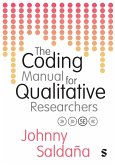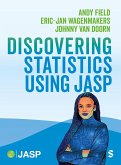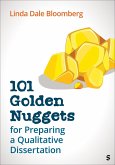- Broschiertes Buch
- Merkliste
- Auf die Merkliste
- Bewerten Bewerten
- Teilen
- Produkt teilen
- Produkterinnerung
- Produkterinnerung
Introducing Communication Research: Paths of Inquiry teaches students the basics of communication research in an accessible manner by using student-focused real-world examples, engaging application exercises, and up-to-date resources. Donald Treadwell guides readers through the process of conducting communication research and presenting findings for a diversity of audiences, and the book emphasizes the Internet and social media as both topics of, and tools for, communication research. The Fifth Edition adds new pedagogical features, a new social media and big data section in each method…mehr
Andere Kunden interessierten sich auch für
![An Introduction to Statistics and Data Analysis Using Stata® An Introduction to Statistics and Data Analysis Using Stata®]() Lisa DanielsAn Introduction to Statistics and Data Analysis Using Stata®101,99 €
Lisa DanielsAn Introduction to Statistics and Data Analysis Using Stata®101,99 €![The Coding Manual for Qualitative Researchers The Coding Manual for Qualitative Researchers]() Johnny SaldanaThe Coding Manual for Qualitative Researchers48,99 €
Johnny SaldanaThe Coding Manual for Qualitative Researchers48,99 €![Discovering Statistics Using JASP Discovering Statistics Using JASP]() Andy FieldDiscovering Statistics Using JASP47,99 €
Andy FieldDiscovering Statistics Using JASP47,99 €![101 Golden Nuggets for Preparing a Qualitative Dissertation 101 Golden Nuggets for Preparing a Qualitative Dissertation]() Linda Dale Bloomberg101 Golden Nuggets for Preparing a Qualitative Dissertation39,99 €
Linda Dale Bloomberg101 Golden Nuggets for Preparing a Qualitative Dissertation39,99 €![Doing Research in the Real World Doing Research in the Real World]() David E. GrayDoing Research in the Real World42,99 €
David E. GrayDoing Research in the Real World42,99 €![An Introduction to R for Spatial Analysis and Mapping (Third Edition) An Introduction to R for Spatial Analysis and Mapping (Third Edition)]() Chris BrunsdonAn Introduction to R for Spatial Analysis and Mapping (Third Edition)158,99 €
Chris BrunsdonAn Introduction to R for Spatial Analysis and Mapping (Third Edition)158,99 €![Introducing Research Methodology Introducing Research Methodology]() Uwe FlickIntroducing Research Methodology133,99 €
Uwe FlickIntroducing Research Methodology133,99 €-
-
-
Introducing Communication Research: Paths of Inquiry teaches students the basics of communication research in an accessible manner by using student-focused real-world examples, engaging application exercises, and up-to-date resources. Donald Treadwell guides readers through the process of conducting communication research and presenting findings for a diversity of audiences, and the book emphasizes the Internet and social media as both topics of, and tools for, communication research. The Fifth Edition adds new pedagogical features, a new social media and big data section in each method chapter, coverage throughout of the impact of artificial intelligence (AI) and particularly in relation to reporting and presenting research; and references the latest research and data sources related to changes in communication brought about by the COVID-19 pandemic. Included with this title: LMS Cartridge: Import this title's instructor resources into your school's learning management system (LMS) and save time. Don¿t use an LMS? You can still access all of the same online resources for this title via the password-protected Instructor Resource Site.
Produktdetails
- Produktdetails
- Verlag: SAGE Publications Inc
- 5 Revised edition
- Seitenzahl: 342
- Erscheinungstermin: 26. Juli 2024
- Englisch
- Abmessung: 254mm x 203mm x 22mm
- Gewicht: 748g
- ISBN-13: 9781071886632
- ISBN-10: 1071886630
- Artikelnr.: 69579641
- Herstellerkennzeichnung Die Herstellerinformationen sind derzeit nicht verfügbar.
- Verlag: SAGE Publications Inc
- 5 Revised edition
- Seitenzahl: 342
- Erscheinungstermin: 26. Juli 2024
- Englisch
- Abmessung: 254mm x 203mm x 22mm
- Gewicht: 748g
- ISBN-13: 9781071886632
- ISBN-10: 1071886630
- Artikelnr.: 69579641
- Herstellerkennzeichnung Die Herstellerinformationen sind derzeit nicht verfügbar.
Donald Treadwell earned his master's degree in communication from Cornell University and his PhD in communication and rhetoric from Rensselaer Polytechnic Institute. He developed and taught communication research classes in classroom and online settings and also taught courses in organizational communication, public relations, and public relations writing. He is the coauthor of Public Relations Writing: Principles in Practice (2nd ed., Sage, 2005). He has published and presented research on organizational image, consumer response to college names, health professionals' images of AIDS, faculty perceptions of the communication discipline, and employers' expectations of newly hired communication graduates. His research appears in Communication Monographs, Journal of Technical Writing and Communication, Public Relations Review, Journal of Human Subjectivity, and Criminal Justice Ethics. He is professor emeritus, Westfield State University, and has international consulting experience in agricultural extension and health communication.
Chapter 1: Foundations: The Ideas That Shape Our Research
Chapter Overview
Getting Started in Research: Assumptions and Decisions
Starting With Basic Beliefs and Perspectives
General Questions Behind Communication Research
Looking Ahead: Web Worlds, Fuzzy Boundaries and Artificial Intelligence
Examples and Insights: "Better Than Sex"
Chapter 2: Getting Started: From Inspiration to Implementation
Chapter Overview
The Relationship Between Theory and Observations
Starting With a Model or Theory
Starting With "5W+H" Questions
Starting With a Focus
Operationalizing Constructs
Starting With a Purpose
Starting With the Work of Others
The Unavoidable Decisions
Examples and Insights: Facing a Meta/Facebook Furor With Further Findings
Chapter 3: Ethics: Our Responsibilities as Researchers
Chapter Overview
Introduction: Some Ethical Decisions
Ethics Issues in Communication Research
Some Classic Ethical Positions
Two Brief Histories-or Why We Care About Research Ethics
Contemporary Codes of Ethics
Regulations
Peer Review and Institutional Review Boards
What Should I Call You? The Ethics of Involvement
The Internet and Research Ethics
Informed Consent and Debriefing on the Internet
Examples and Insights: Making Consent Forms Shorter
Chapter 4: Resources: Reading, Recording, and Reviewing Research
Chapter Overview
Library Research: Why Bother?
Finding Relevance
Finding Quality
Search Strategies and Techniques
The Literature Review: Writing Your Search Results
Examples and Insights: Predatory Journals
Chapter 5: Measurement: Research Using Numbers
Chapter Overview
What Do Your Head Size, Attitudes, and Readability Have in Common?
Research NOIR
To NOIR Is Not Enough: Reliability and Validity
Two Common Measurement Scales
Communication Research Measures as a Work in Progress
Examples and Insights: Off-the-Shelf Communication Research Measures
Social Media, Big Data, and Measurement
Chapter 6: Sampling: Who, What, and How Many?
Chapter Overview
Introduction
Nonprobability Sampling
Probability Sampling
How Big Does My Sample Have to Be?
Selecting a Sampling Frame
Special Population Sampling
The Future of Sampling
Examples and Insights: Student Participation
Social Media, Big Data, and Sampling
Chapter 7: Statistics: Choosing and Using Quantitative Tools
Chapter Overview
Introduction
But First-Data Cleanup and Categorization
Describing Data: Descriptive Statistics
Inferential Statistics
Assessing Results
Accept or Reject My Findings?
Examples and Insights: Evaluating Quantitative Studies
Big Data: Analysis
Chapter 8: Surveys: Putting Numbers on Opinions
Chapter Overview
Introduction: Advantages and Disadvantages of Surveys
Types Of Surveys
Survey Methods
Writing, Introducing, and Formatting Survey Questions
Survey Wording: "If It Can Be Misinterpreted, It Will Be"
Web and Mobile Survey Design
Improving Survey Response Rates
Using Other People's Surveys
Examples and Insights: Assessing Survey Credibility
Big Data and Surveys
Chapter 9: Experiments: Researching Cause and Effect
Chapter Overview
Introduction: Advantages and Disadvantages of Experiments
Field Experiments and Ex Post Facto Designs
Designing for Control
Factorial Designs
Between-Subjects and Within-Subjects Design
Time Series Analysis
Validity and Experimental Design
Examples and Insights: Researching Selfies
Big Data and Online Experiments
Experiments Revisited
Chapter 10: Content Analysis I: Quantitative Understanding of Words and
Images
Chapter Overview
Introduction: Advantages and Disadvantages of Content Analysis
A Basic Content Analysis
Content Analysis of Human Interaction
Coding and Latent Content
Content Analysis as Quantitative and Qualitative
Computer Analysis of Content
Examples and Insights: Predictions From Social Media
Big Data and Content Analysis
Getting Started
Chapter 11: Content Analysis II: Qualitative Understandings of Words and
Images
Chapter Overview
Introduction: Advantages and Disadvantages of Qualitative Analyses of
Content
Rhetorical Analyses
Narrative, Fantasy, Discourse, and Conversation Analyses
Semiotics and Metaphor
Critical Analyses
Visual Rhetorical Analyses
Examples and Insights: Qualitative Content Analysis and Qualitative Content
Analysis
Social Media, Big Data, and Multimodal Analysis
Chapter 12: Observation: Qualitative Understandings of Behaviors and
Attitudes
Chapter Overview
Introduction: Advantages and Disadvantages of Qualitative Methods
Qualitative and Quantitative: Similarities and Differences
Researcher-Participant Relationships
Watching and Listening Methods
Making Sense of Qualitative Data
Examples and Insights: Reflexivity and Social Media Research
Social Media, Big Data, and Qualitative Research
Chapter 13: Now What? Reporting and Presenting Research Results
Chapter Overview
Introduction
The Publics of Research
The Voices of Research
Disseminating Research Findings
Visualizing Research Results
Examples and Insights: Researching the Impact of Presentation Media and
Audience Interaction
Social Media, Big Data, Visualization, and Artificial Intelligence
Chapter Overview
Getting Started in Research: Assumptions and Decisions
Starting With Basic Beliefs and Perspectives
General Questions Behind Communication Research
Looking Ahead: Web Worlds, Fuzzy Boundaries and Artificial Intelligence
Examples and Insights: "Better Than Sex"
Chapter 2: Getting Started: From Inspiration to Implementation
Chapter Overview
The Relationship Between Theory and Observations
Starting With a Model or Theory
Starting With "5W+H" Questions
Starting With a Focus
Operationalizing Constructs
Starting With a Purpose
Starting With the Work of Others
The Unavoidable Decisions
Examples and Insights: Facing a Meta/Facebook Furor With Further Findings
Chapter 3: Ethics: Our Responsibilities as Researchers
Chapter Overview
Introduction: Some Ethical Decisions
Ethics Issues in Communication Research
Some Classic Ethical Positions
Two Brief Histories-or Why We Care About Research Ethics
Contemporary Codes of Ethics
Regulations
Peer Review and Institutional Review Boards
What Should I Call You? The Ethics of Involvement
The Internet and Research Ethics
Informed Consent and Debriefing on the Internet
Examples and Insights: Making Consent Forms Shorter
Chapter 4: Resources: Reading, Recording, and Reviewing Research
Chapter Overview
Library Research: Why Bother?
Finding Relevance
Finding Quality
Search Strategies and Techniques
The Literature Review: Writing Your Search Results
Examples and Insights: Predatory Journals
Chapter 5: Measurement: Research Using Numbers
Chapter Overview
What Do Your Head Size, Attitudes, and Readability Have in Common?
Research NOIR
To NOIR Is Not Enough: Reliability and Validity
Two Common Measurement Scales
Communication Research Measures as a Work in Progress
Examples and Insights: Off-the-Shelf Communication Research Measures
Social Media, Big Data, and Measurement
Chapter 6: Sampling: Who, What, and How Many?
Chapter Overview
Introduction
Nonprobability Sampling
Probability Sampling
How Big Does My Sample Have to Be?
Selecting a Sampling Frame
Special Population Sampling
The Future of Sampling
Examples and Insights: Student Participation
Social Media, Big Data, and Sampling
Chapter 7: Statistics: Choosing and Using Quantitative Tools
Chapter Overview
Introduction
But First-Data Cleanup and Categorization
Describing Data: Descriptive Statistics
Inferential Statistics
Assessing Results
Accept or Reject My Findings?
Examples and Insights: Evaluating Quantitative Studies
Big Data: Analysis
Chapter 8: Surveys: Putting Numbers on Opinions
Chapter Overview
Introduction: Advantages and Disadvantages of Surveys
Types Of Surveys
Survey Methods
Writing, Introducing, and Formatting Survey Questions
Survey Wording: "If It Can Be Misinterpreted, It Will Be"
Web and Mobile Survey Design
Improving Survey Response Rates
Using Other People's Surveys
Examples and Insights: Assessing Survey Credibility
Big Data and Surveys
Chapter 9: Experiments: Researching Cause and Effect
Chapter Overview
Introduction: Advantages and Disadvantages of Experiments
Field Experiments and Ex Post Facto Designs
Designing for Control
Factorial Designs
Between-Subjects and Within-Subjects Design
Time Series Analysis
Validity and Experimental Design
Examples and Insights: Researching Selfies
Big Data and Online Experiments
Experiments Revisited
Chapter 10: Content Analysis I: Quantitative Understanding of Words and
Images
Chapter Overview
Introduction: Advantages and Disadvantages of Content Analysis
A Basic Content Analysis
Content Analysis of Human Interaction
Coding and Latent Content
Content Analysis as Quantitative and Qualitative
Computer Analysis of Content
Examples and Insights: Predictions From Social Media
Big Data and Content Analysis
Getting Started
Chapter 11: Content Analysis II: Qualitative Understandings of Words and
Images
Chapter Overview
Introduction: Advantages and Disadvantages of Qualitative Analyses of
Content
Rhetorical Analyses
Narrative, Fantasy, Discourse, and Conversation Analyses
Semiotics and Metaphor
Critical Analyses
Visual Rhetorical Analyses
Examples and Insights: Qualitative Content Analysis and Qualitative Content
Analysis
Social Media, Big Data, and Multimodal Analysis
Chapter 12: Observation: Qualitative Understandings of Behaviors and
Attitudes
Chapter Overview
Introduction: Advantages and Disadvantages of Qualitative Methods
Qualitative and Quantitative: Similarities and Differences
Researcher-Participant Relationships
Watching and Listening Methods
Making Sense of Qualitative Data
Examples and Insights: Reflexivity and Social Media Research
Social Media, Big Data, and Qualitative Research
Chapter 13: Now What? Reporting and Presenting Research Results
Chapter Overview
Introduction
The Publics of Research
The Voices of Research
Disseminating Research Findings
Visualizing Research Results
Examples and Insights: Researching the Impact of Presentation Media and
Audience Interaction
Social Media, Big Data, Visualization, and Artificial Intelligence
Chapter 1: Foundations: The Ideas That Shape Our Research
Chapter Overview
Getting Started in Research: Assumptions and Decisions
Starting With Basic Beliefs and Perspectives
General Questions Behind Communication Research
Looking Ahead: Web Worlds, Fuzzy Boundaries and Artificial Intelligence
Examples and Insights: "Better Than Sex"
Chapter 2: Getting Started: From Inspiration to Implementation
Chapter Overview
The Relationship Between Theory and Observations
Starting With a Model or Theory
Starting With "5W+H" Questions
Starting With a Focus
Operationalizing Constructs
Starting With a Purpose
Starting With the Work of Others
The Unavoidable Decisions
Examples and Insights: Facing a Meta/Facebook Furor With Further Findings
Chapter 3: Ethics: Our Responsibilities as Researchers
Chapter Overview
Introduction: Some Ethical Decisions
Ethics Issues in Communication Research
Some Classic Ethical Positions
Two Brief Histories-or Why We Care About Research Ethics
Contemporary Codes of Ethics
Regulations
Peer Review and Institutional Review Boards
What Should I Call You? The Ethics of Involvement
The Internet and Research Ethics
Informed Consent and Debriefing on the Internet
Examples and Insights: Making Consent Forms Shorter
Chapter 4: Resources: Reading, Recording, and Reviewing Research
Chapter Overview
Library Research: Why Bother?
Finding Relevance
Finding Quality
Search Strategies and Techniques
The Literature Review: Writing Your Search Results
Examples and Insights: Predatory Journals
Chapter 5: Measurement: Research Using Numbers
Chapter Overview
What Do Your Head Size, Attitudes, and Readability Have in Common?
Research NOIR
To NOIR Is Not Enough: Reliability and Validity
Two Common Measurement Scales
Communication Research Measures as a Work in Progress
Examples and Insights: Off-the-Shelf Communication Research Measures
Social Media, Big Data, and Measurement
Chapter 6: Sampling: Who, What, and How Many?
Chapter Overview
Introduction
Nonprobability Sampling
Probability Sampling
How Big Does My Sample Have to Be?
Selecting a Sampling Frame
Special Population Sampling
The Future of Sampling
Examples and Insights: Student Participation
Social Media, Big Data, and Sampling
Chapter 7: Statistics: Choosing and Using Quantitative Tools
Chapter Overview
Introduction
But First-Data Cleanup and Categorization
Describing Data: Descriptive Statistics
Inferential Statistics
Assessing Results
Accept or Reject My Findings?
Examples and Insights: Evaluating Quantitative Studies
Big Data: Analysis
Chapter 8: Surveys: Putting Numbers on Opinions
Chapter Overview
Introduction: Advantages and Disadvantages of Surveys
Types Of Surveys
Survey Methods
Writing, Introducing, and Formatting Survey Questions
Survey Wording: "If It Can Be Misinterpreted, It Will Be"
Web and Mobile Survey Design
Improving Survey Response Rates
Using Other People's Surveys
Examples and Insights: Assessing Survey Credibility
Big Data and Surveys
Chapter 9: Experiments: Researching Cause and Effect
Chapter Overview
Introduction: Advantages and Disadvantages of Experiments
Field Experiments and Ex Post Facto Designs
Designing for Control
Factorial Designs
Between-Subjects and Within-Subjects Design
Time Series Analysis
Validity and Experimental Design
Examples and Insights: Researching Selfies
Big Data and Online Experiments
Experiments Revisited
Chapter 10: Content Analysis I: Quantitative Understanding of Words and
Images
Chapter Overview
Introduction: Advantages and Disadvantages of Content Analysis
A Basic Content Analysis
Content Analysis of Human Interaction
Coding and Latent Content
Content Analysis as Quantitative and Qualitative
Computer Analysis of Content
Examples and Insights: Predictions From Social Media
Big Data and Content Analysis
Getting Started
Chapter 11: Content Analysis II: Qualitative Understandings of Words and
Images
Chapter Overview
Introduction: Advantages and Disadvantages of Qualitative Analyses of
Content
Rhetorical Analyses
Narrative, Fantasy, Discourse, and Conversation Analyses
Semiotics and Metaphor
Critical Analyses
Visual Rhetorical Analyses
Examples and Insights: Qualitative Content Analysis and Qualitative Content
Analysis
Social Media, Big Data, and Multimodal Analysis
Chapter 12: Observation: Qualitative Understandings of Behaviors and
Attitudes
Chapter Overview
Introduction: Advantages and Disadvantages of Qualitative Methods
Qualitative and Quantitative: Similarities and Differences
Researcher-Participant Relationships
Watching and Listening Methods
Making Sense of Qualitative Data
Examples and Insights: Reflexivity and Social Media Research
Social Media, Big Data, and Qualitative Research
Chapter 13: Now What? Reporting and Presenting Research Results
Chapter Overview
Introduction
The Publics of Research
The Voices of Research
Disseminating Research Findings
Visualizing Research Results
Examples and Insights: Researching the Impact of Presentation Media and
Audience Interaction
Social Media, Big Data, Visualization, and Artificial Intelligence
Chapter Overview
Getting Started in Research: Assumptions and Decisions
Starting With Basic Beliefs and Perspectives
General Questions Behind Communication Research
Looking Ahead: Web Worlds, Fuzzy Boundaries and Artificial Intelligence
Examples and Insights: "Better Than Sex"
Chapter 2: Getting Started: From Inspiration to Implementation
Chapter Overview
The Relationship Between Theory and Observations
Starting With a Model or Theory
Starting With "5W+H" Questions
Starting With a Focus
Operationalizing Constructs
Starting With a Purpose
Starting With the Work of Others
The Unavoidable Decisions
Examples and Insights: Facing a Meta/Facebook Furor With Further Findings
Chapter 3: Ethics: Our Responsibilities as Researchers
Chapter Overview
Introduction: Some Ethical Decisions
Ethics Issues in Communication Research
Some Classic Ethical Positions
Two Brief Histories-or Why We Care About Research Ethics
Contemporary Codes of Ethics
Regulations
Peer Review and Institutional Review Boards
What Should I Call You? The Ethics of Involvement
The Internet and Research Ethics
Informed Consent and Debriefing on the Internet
Examples and Insights: Making Consent Forms Shorter
Chapter 4: Resources: Reading, Recording, and Reviewing Research
Chapter Overview
Library Research: Why Bother?
Finding Relevance
Finding Quality
Search Strategies and Techniques
The Literature Review: Writing Your Search Results
Examples and Insights: Predatory Journals
Chapter 5: Measurement: Research Using Numbers
Chapter Overview
What Do Your Head Size, Attitudes, and Readability Have in Common?
Research NOIR
To NOIR Is Not Enough: Reliability and Validity
Two Common Measurement Scales
Communication Research Measures as a Work in Progress
Examples and Insights: Off-the-Shelf Communication Research Measures
Social Media, Big Data, and Measurement
Chapter 6: Sampling: Who, What, and How Many?
Chapter Overview
Introduction
Nonprobability Sampling
Probability Sampling
How Big Does My Sample Have to Be?
Selecting a Sampling Frame
Special Population Sampling
The Future of Sampling
Examples and Insights: Student Participation
Social Media, Big Data, and Sampling
Chapter 7: Statistics: Choosing and Using Quantitative Tools
Chapter Overview
Introduction
But First-Data Cleanup and Categorization
Describing Data: Descriptive Statistics
Inferential Statistics
Assessing Results
Accept or Reject My Findings?
Examples and Insights: Evaluating Quantitative Studies
Big Data: Analysis
Chapter 8: Surveys: Putting Numbers on Opinions
Chapter Overview
Introduction: Advantages and Disadvantages of Surveys
Types Of Surveys
Survey Methods
Writing, Introducing, and Formatting Survey Questions
Survey Wording: "If It Can Be Misinterpreted, It Will Be"
Web and Mobile Survey Design
Improving Survey Response Rates
Using Other People's Surveys
Examples and Insights: Assessing Survey Credibility
Big Data and Surveys
Chapter 9: Experiments: Researching Cause and Effect
Chapter Overview
Introduction: Advantages and Disadvantages of Experiments
Field Experiments and Ex Post Facto Designs
Designing for Control
Factorial Designs
Between-Subjects and Within-Subjects Design
Time Series Analysis
Validity and Experimental Design
Examples and Insights: Researching Selfies
Big Data and Online Experiments
Experiments Revisited
Chapter 10: Content Analysis I: Quantitative Understanding of Words and
Images
Chapter Overview
Introduction: Advantages and Disadvantages of Content Analysis
A Basic Content Analysis
Content Analysis of Human Interaction
Coding and Latent Content
Content Analysis as Quantitative and Qualitative
Computer Analysis of Content
Examples and Insights: Predictions From Social Media
Big Data and Content Analysis
Getting Started
Chapter 11: Content Analysis II: Qualitative Understandings of Words and
Images
Chapter Overview
Introduction: Advantages and Disadvantages of Qualitative Analyses of
Content
Rhetorical Analyses
Narrative, Fantasy, Discourse, and Conversation Analyses
Semiotics and Metaphor
Critical Analyses
Visual Rhetorical Analyses
Examples and Insights: Qualitative Content Analysis and Qualitative Content
Analysis
Social Media, Big Data, and Multimodal Analysis
Chapter 12: Observation: Qualitative Understandings of Behaviors and
Attitudes
Chapter Overview
Introduction: Advantages and Disadvantages of Qualitative Methods
Qualitative and Quantitative: Similarities and Differences
Researcher-Participant Relationships
Watching and Listening Methods
Making Sense of Qualitative Data
Examples and Insights: Reflexivity and Social Media Research
Social Media, Big Data, and Qualitative Research
Chapter 13: Now What? Reporting and Presenting Research Results
Chapter Overview
Introduction
The Publics of Research
The Voices of Research
Disseminating Research Findings
Visualizing Research Results
Examples and Insights: Researching the Impact of Presentation Media and
Audience Interaction
Social Media, Big Data, Visualization, and Artificial Intelligence








